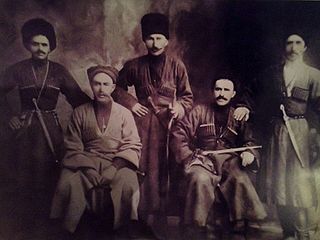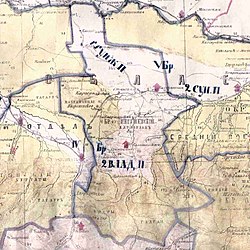Yalkharoy is a rural locality in Urus-Martanovsky District of the Republic of Chechnya, Russia.

Akhmat-Yurt, formerly known as Tsentaroy or Tsentoroy in Russian and Khosi-Yurt in Chechen (Хоси-Юрт), is a rural locality in Kurchaloyevsky District of the Chechen Republic, Russia.

Samashki is a rural locality in Achkhoy-Martanovsky District, Chechnya. Samashki is the administrative center and only settlement of the Samashkinskoye rural settlement. Its population was estimated at 12,769 in 2021.

The Orstkhoy, historically commonly known under their exonyms: Karabulaks, Balsu, Baloy, are a historical ethnoterritorial society among the Chechen and Ingush peoples. Their homeland is in the upper reaches of the Assa and Fortanga rivers in the historical region of Orstkhoy-Mokhk. In the tradition of the Chechen ethno-hierarchy, it is considered one of the nine historical Chechen tukkhums, in the Ingush tradition as one of the seven historical Ingush shahars.

Galain-Chazh is a historical region in the North Caucasus. Today, Galain-Chazh is a part of Galanchozhsky District, Chechnya.

Galanchozhsky District, is a district (raion) of Chechnya. The district was recreated in 2012. However, the official restoration process of the district is not complete. The district also existed between 1925 and 1944. The administrative center is the village of Aka-Bass.
Khaybakha, also spelled Khaibakha or Khaibakh, is a non-residential village in Galanchozhsky District, Chechnya.

Assinovskaya is rural locality in Sernovodsky District of the Republic of Chechnya, Russia.
Bamut is a non-residential rural locality in Sernovodsky District of the Republic of Chechnya, Russia. From 1922 to 1934, Bamut was a part of the Ingush Autonomous Oblast.
Valerik is a rural locality in Achkhoy-Martanovsky District, Chechnya.
Katyr-Yurt is a rural locality in Achkhoy-Martanovsky District, Chechnya.
Yandi is a rural locality in Achkhoy-Martanovsky District, Chechnya.
Kulary is a rural locality in Achkhoy-Martanovsky District, Chechnya.
Chozhi-Chu was a rural locality in Achkhoy-Martanovsky District, Chechnya.

The Dzherakh, also spelled Jerakh, historically also known as Erokhan people, were a historical Ingush ethnoterritorial society, today a tribal organization/clan (teip), that was formed in the Dzheyrakhin gorge, as well as in the area of the lower reaches of the Armkhi River and the upper reaches of the Terek River.

Tsorins, Tsori, also Ghalghaï, were a historical Ingush ethnoterritorial society that was located in mountainous Ingushetia in the region of river Guloykhi. The center of the society was Tsori from which it got its name. Tsorin society, like the Khamkhin society, was formed from the former "Galgaï society" as a result of the transfer (appearance) of rural government to the village Tsori.

Barsuki is a rural locality in Nazranovsky District of the Republic of Ingushetia, Russia. It forms the municipality of the rural settlement of Barsuki as the only settlement in its composition.

Ingush okrug was a district (okrug) of the Terek Oblast of the Caucasus Viceroyalty of the Russian Empire. The area of the Ingushskiy okrug made up part of the North Caucasian Federal District of Russia.
Khay is a non-residential rural locality in Achkhoy-Martanovsky District of the Republic of Chechnya, Russia.

Meredzhi is a non-residential rural locality in Galanchozhsky District of the Republic of Chechnya, Russia.
















